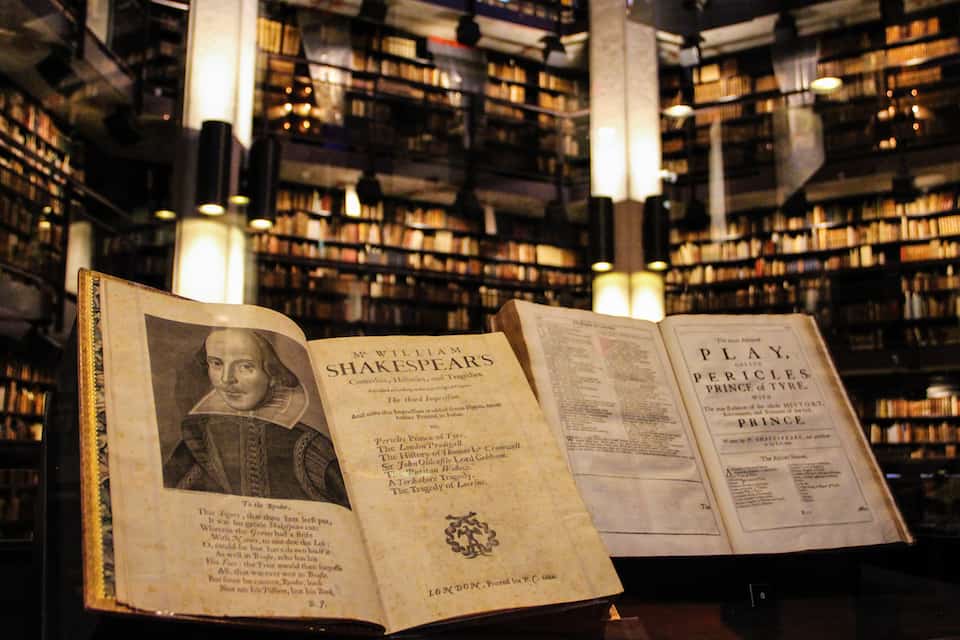“So long as men can breathe, or eyes can see, so long lives this, and this gives life to thee,” reads “Sonnet 18,” one of William Shakespeare’s best known poems. Centred on romance and illuminating its own immortality, it inspired the Thomas Fisher Rare Book Library’s latest exhibition ‘So Long Lives This:’ Celebrating Shakespeare, 1616–2016. Marking the four hundredth anniversary of Shakespeare’s death, much of the playwright’s work is currently on display at the library.
The Thomas Fisher Rare Book Library is an esoteric time capsule accessed mostly by grad students — a bibliophile’s utopia. Past the secured entranceway, the remnants of the artifacts rest enclosed in glass display cases adorned with banners and a bust of the man himself.
The first case holds Shakespeare’s First Folio, produced in 1623 — seven years after Shakespeare’s death — by printer and publisher Isaac Jaggard. It is on display to show the table of contents and notes a few print errors. Of the 230 surviving copies today, it is the only copy in Canada and was gifted by Sidney Fisher at the library’s grand opening in 1973.
Accompanying the First Folio is Thomas Wilson’s A Christian Dictionary, the first biblical English dictionary. Another piece is Andre Fayn’s The Theater of Honour and Knight-hood, which features heraldic, meticulously hand-colored illustrations, along with a note by stationer George Lathum proclaiming, “I warrant this book perfect.”
The second case holds Shakespeare’s Second Folio (1632), Third Folio (1663), and Fourth Folio (1685); the third one remains the rarest of them all and contains seven additional plays. All four folios were published posthumously and remained largely unedited, until they gained popularity among scholars in the 1700s.
The workmanship of the time period is emphasized throughout the exhibit. The third case is dedicated to showcasing William Jaggard and his publishing colleagues’ expert craft. Thomas Milles’ Catalogue of Honor bears an intricate engraving of classical figures writing Latin on stone.
A 1613 pocket-sized edition of Francis Bacon’s philosophical Essays is bound in vellum. Ralph Brooke’s catalogue of English royalty is strikingly hand-coloured in vibrant red, blue, white, and yellow. Robert Glover’s Nobilitas Politica Vel Ciuilis is one of William Jaggard’s most ambitious printings and illustrates a majestic engraving of Queen Elizabeth I in parliament.
The exhibition also showcases a wide variety of ancient writing. The fourth display case highlights works that Shakespeare read during his writing process. Raphael Holinshed’s The First and Second Volumes of Chronicles shows a landscape similar to the Garden of Eden, which contained the most extensive history of England, Ireland, Scotland, and Wales that was available during the period. Shakespeare also turned to Plutarch’s The Lives of the Noble Grecians and Romanes (1579) for the history of famous figures like Julius Caesar or for the romance of Antony and Cleopatra. Shakespeare alludes to Ovid’s Metamorphoses in several of his plays, including Richard II, Twelfth Night, and A Midsummer Night’s Dream.
The fifth display case highlights linguistic history by showcasing words as a globally influenced form of calligraphy. John Baret’s An Alvearie, or Quadruple Dictionarie contains a multilingual mélange. Henry Cockeram’s English Dictionary is the first monolingual English book, self-described as a dictionary; it was created for the general public rather than the linguistically elite to help with difficult words. Robert Dodsley’s On Biblical Subjects shows exquisite hand illustrations containing a prophetic curse, which the reader enacts by lifting up the paper’s flaps.
The finale of the main floor is case eight, which displays modern twentieth century productions, including works by Toronto locals. Don Taylor’s Illustrations for Macbeth (2012) is an eerie-looking book that features aesthetic bloodstains of ‘Dechard Rinderpest’, a pseudonym of a local actor driven insane by his role as Lady Macbeth. Robert Wu’s cover designs are displayed via several preparatory sketches in the lower Maclean Hunter Room, among other varying treasures.
The exhibit is much more than Shakespeare alone. It moves chronologically through history, and in doing so, exemplifies the British playwright’s tremendous legacy.


